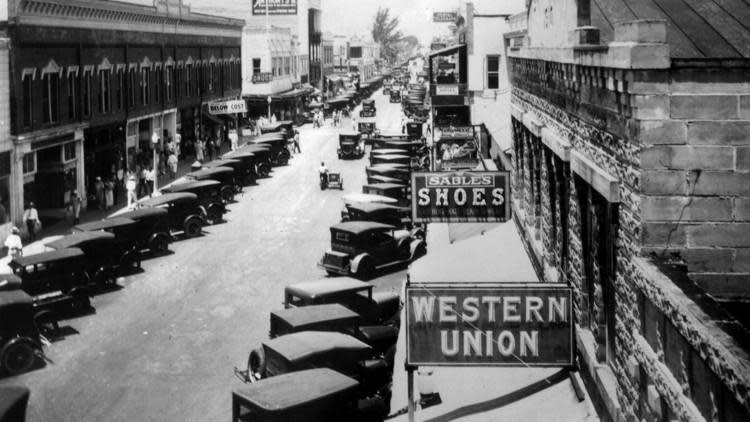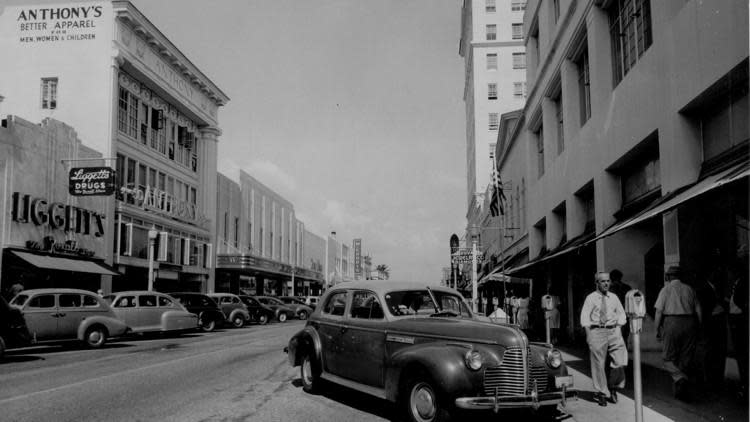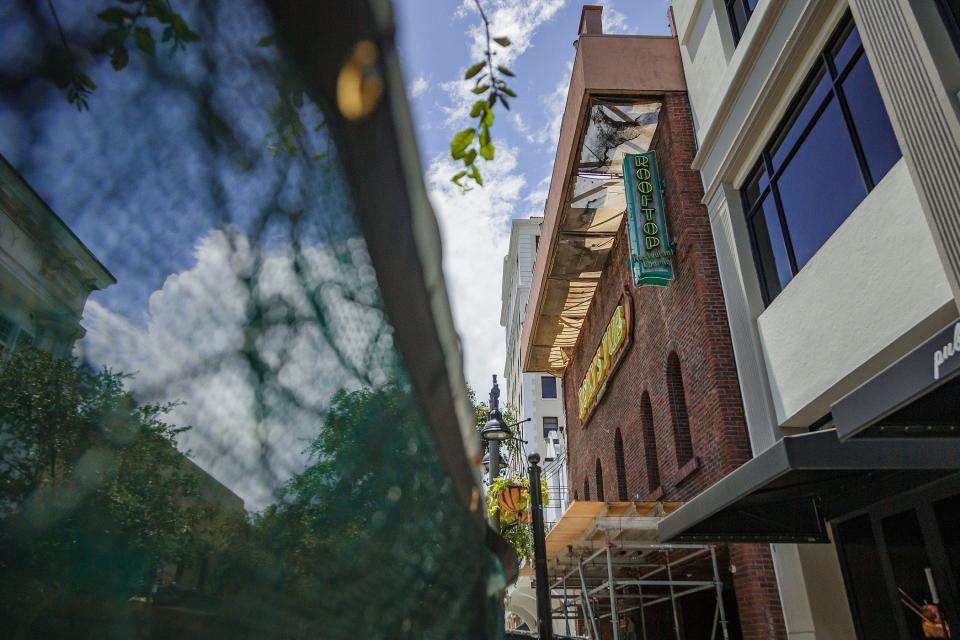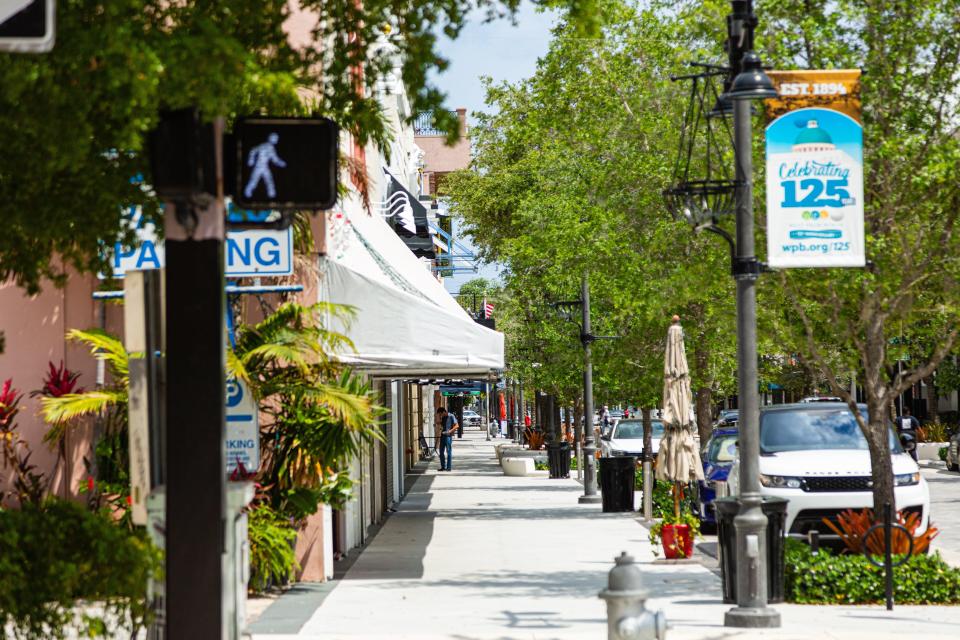Throwback Thursday: What West Palm Beach's Clematis Street used to look like, why we mispronounce it

Editor’s note: From our archives: This story was originally published in 2017.
The street names themselves must have been an intoxicating advertisement for the tiny settlement across the lake from the posh Palm Beach resort.
Hibiscus, Banyan, Gardenia, Sapodilla and Tamarind.
Who up north in the 1890s had ever heard such exotic names, like balmy breezes wafting from an Eden being built alongside Mr. Flagler’s new railroad?
On November 5, 1894 — 123 years ago — a small group of residents voted to make their fledgling town a city in what was then Dade County, where the streets were named for the tropical trees and flowers new residents could grow in their own backyards.
But someone goofed in the naming of Clematis Street.
The colorful history of 314 Clematis: A hookah lounge, furniture store and iconic department store
Clematis Street in the early 1900's

The namesake of downtown West Palm Beach’s main street isn’t a tropical flower, but a northern flowering vine that doesn’t tolerate our steamy summers. In fact, clematis is so foreign to the subtropics that we’ve mispronounced its name for more than 100 years.
The flower’s name is pronounced CLEM-a-tis — even a crisp Clem-AYE-tis is acceptable, if you’re British — but never the way we say it, with that lazy Southern syllable malingering in the middle: Cle-MAAHH-tis.
“Everybody came from all over the place back then,” said Debi Murray, the chief curator of the Historical Society of Palm Beach County, who grew up in Palm Beach County. “Because of it, we have always had our own strange way of saying things.”
And, it wasn’t always Clematis “Street.” Briefly, it had grander aspirations.
“On the 1893 map, the year before incorporation, it’s printed as Clematis Avenue,” said Murray. “It’s the only one called an avenue.”
But Clematis Street by any pronunciation or suffix is still the city’s main drag.
How they got their names: Here's how Jupiter Inlet, Loxahatchee Groves, Manalapan, other towns got their names
“Clematis Street is the heart and soul of the city,” said Rick Gonzalez, an architect and historic preservationist who leads historic walking tours of downtown West Palm Beach and whose firm has restored many of its oldest buildings. “With Flagler Drive, it’s the essence of who we are. Its buildings are an eclectic mix of architectural styles and periods from the 1890s to today that reflect the growth of the city.”
He cites a few of his favorite Clematis Street buildings: the 1926 Comeau Building at 319 Clematis, with its graceful interior courtyard; the 1919 former Anthony’s building at 312; the Art Deco Woolworth Building at 313; the ornate Venetian-style First American Bank building at 300, as well as the brick facade of the building housing Rocco’s Tacos dating from the 1890s.
Local history: Remember Palm Beach County’s nude doughnut shop?
West Palm Beach's history
In its earliest years, the city was little more than housing for workers building the hotels and mansions in Palm Beach.
The same year the city was founded, a resident described the town as “a stretch of the whitest of white sand, two steel rails, a few acres of pineapples, a couple of houses, and ‘scrub’ on every side.”
Clematis Street, running west from a point of land stuck out into Lake Worth (the Intracoastal Waterway), became the city’s street of “firsts.”
The city’s first business, a wooden hardware store, went up on Clematis Street in 1893 while the proprietor’s family lived in a tent next door. The first school (for whites, anyway), the first post office, the first drugstore, the first library all opened on Clematis Street.
Many were destroyed when two big fires consumed most of the tiny business district two weeks apart in 1896, prompting the city to require that new buildings be made of brick or cement.
“In the old days, people would get off the train, then walk to Clematis, where they could get a job, buy a house, buy groceries, furniture, everything was there,” said Gonzalez.
It has always been the heart of the city’s civic and business life.
“One of the constants about Clematis is that is where all the celebrations happened,” said Murray. “Parades, dancing in the street during the old Seminole Sun Dances, the fire department marched there in 1906, anything official was held there.”
During the 20th century’s world wars, Clematis hosted military parades and victory celebrations. Until the Palm Beach Mall opened in 1967, it was Palm Beach County’s major middle-class shopping street.
“There were always people all over the place,” said Murray, who remembers going as a child to shop at Burdines and Belks, when a shopping trip always included lunch at Walgreen’s.
Before The Gardens Mall: How north county’s shopping mecca turned shabby
Parking has been a problem on the street since cars were invented. During the land boom of the early 1920′s, photos show Model T’s parked diagonally in the center of the street but a few years later, the city designated diagonal parking on both sides of the streets. In the 1960s, ’70s and ’80s, Clematis became a one-way street going west. In the 1990s, the street was narrowed to create wider sidewalks, with parallel parking.
Clematis Street revived in downtown West Palm Beach


After the people followed the stores to the mall, Clematis Street became one more desolate urban core in the 1970s and ’80s, until the historic preservation movement prompted a new look at the old street in the heart of the city.
Following demolition of the 1960s-era library at the street’s east end, the city constructed a civic plaza with interactive fountain and green open space known as the Great Lawn, designed for festivals.
Clematis saw a retail resurgence in the 1990s, when Gap, Loft and Banana Republic opened in turn-of-the-century storefronts and then-developer Donald Trump in 1999 told People it was “the hottest street in Florida.”
However, the opening of CityPlace a few blocks away in 2000 again sucked the retail life from the street, leaving a few century-old stalwarts such as Myers Luggage, which opened in 1924 and Pioneer Linens, founded in 1912. JC Harris, a men’s shop, closed in 2013 after 100 years.
In the 1980s, entrepreneur Rodney Mayo began turning the blighted west end of Clematis into the center of cool for alternative music lovers by opening Respectable Street Cafe, a concert venue, in an old Salvation Army. These days, those grown-up music lovers flock to Mayo’s five restaurants, some owned with partners, that line the 500 block, the street’s only block with historical designation.
In the ’90s and early 2000′s, Clematis was packed with nightclubs like Dr. Feelgood’s, whose loud bands clashed with the Boomer crowd buying the new downtown condos elevating the city’s skyline.
The clubs gave way to both chain and chef-run restaurants and bars, opening and closing as the street underwent periodic boom and bust cycles.
Recent history includes the new combination city hall and library opened on Clematis Street and the city’s Greenmarket at the street’s east end, which attracts large crowds on Saturday mornings from October through April.
Currently, the city is mulling ways to make Clematis Street and the rest of downtown shadier while getting people out of their cars and on foot or bikes.
While retail has never returned in a large scale, Clematis is again busy day and night with people attracted to an array of inventive restaurants tucked into century-old buildings, whose outdoor tables dot the crowded sidewalks.
“It’s a street that’s been through thick and thin over 13 decades,” said Gonzalez. “Clematis is the official phoenix. It’s always coming back.”
No matter how we pronounce it.
This article originally appeared on Palm Beach Post: Throwback Thurday: What West Palm Beach used to look like in 1900's

